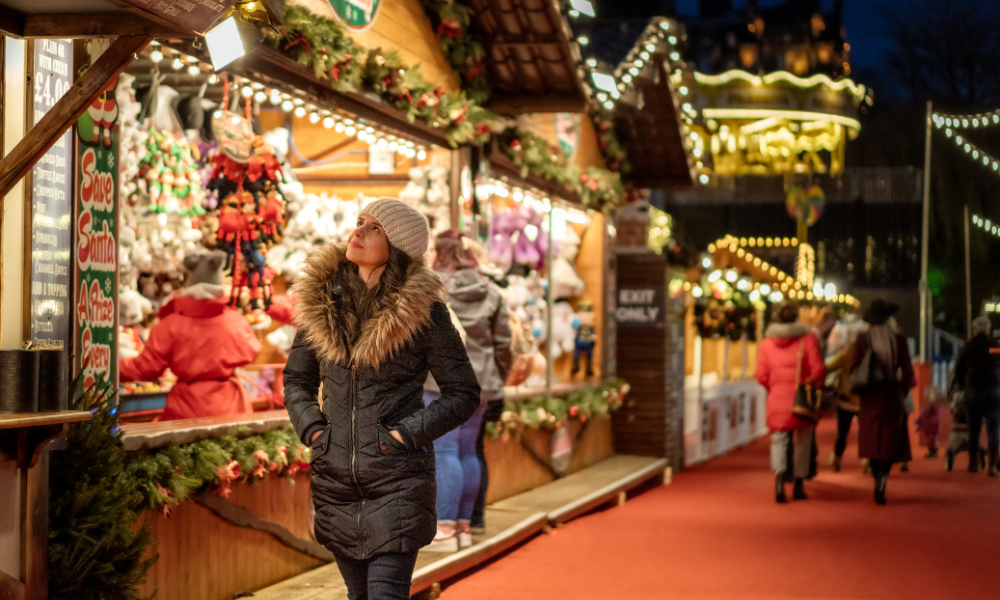A brisk wind blows, making the twinkling lights and evergreen boughs sway, and carrying the scent of freshly baked pastries and warming wine to shoppers who browse at open-air stalls, searching for the perfect homemade gift or treat. It’s a magical, beautiful and festive Christkindl markets, or Christmas markets, a centuries-old European tradition that is increasingly popular across North America.
‘Tis the Season for Christmas Markets
Whatever the name, the markets typically include small vendors, each housed in individual, often rustic, wooden stalls; selling food, hot beverages including mulled wine and hot cocoa, pastries, handcrafted items, and more. Most markets are decked out in holiday décor, abundant twinkling lights and may even include live musical performances or fun activities such as ice skating and crafting.
European Christmas markets can be traced back as far as the 13th century, with one of the first examples being Vienna in 1296 when Duke Albrecht I authorized 14-day fairs in the month of December, according to Smithsonian magazine.
Historians don’t like to identify the first official Christmas market, but some of the oldest continually operating annual markets include the Dresden Striezelmarkt, which started in 1434, and the Nuremburg Christkindlesmarkt, which began no later than 1628.
The markets have mainly German origins, the Smithsonian article said, but they eventually spread to parts of Italy, Switzerland, and France. Today, Germany hosts around 3,000 Christmas markets annually, it said. Markets can now be found throughout the world.
Perhaps because Christmas markets don’t have as deep a history yet in the US, they aren’t viewed as an essential part of the season, when compared to Europe. One study found that 58% of Germans said that Christmas markets are essential, and half were looking forward to them. In the US, only 13% saw it as an important tradition and looked forward to it. For Americans, listening to Christmas music, putting up a tree and watching holiday movies were more important.
Anecdotally, it seems the number of markets in the US is increasing. Chicago’s Christkindlmarket started in 1996, and it regularly ranks among the top 10 markets in the world. It is inspired by the Nuremburg market of the same name and is considered one of the closest to a European market experience in North America.
Other popular major metropolitan markets in the US include San Francisco, New York City, and Washington, DC.
Local towns are creating their own, smaller markets, and individual businesses have started offering mini-Christmas markets for a few weekends in December. For example, in Illinois, two breweries set up Christmas markets for limited runs with a handful of vendors. They showcased their own libations while inviting vendors to sell homemade goods and snacks.
Christmas markets have proven profitable for the small-business vendors as well as the market host. In 2021, the markets in Chicago and the Wrigleyville neighborhood added $196.2 million to the Cook County economy. Attendance at the two markets totaled 1.5 million visitors, more than half of which spent money on activities in Chicago outside of the market.
For artisans and small-business owners, the markets can be a tremendous boon and provide significant percentages of their annual revenue, according to Marketplace. However, renting space at a market can also be expensive, running from hundreds to thousands of dollars.
Business owners must decide if the markets are worth the fees being charged. In Washington, DC, vendors can pay $400-$500 per day for a booth, but they can also expect 10,000 visitors on a weekday and 20,000 on a weekend.
One vendor who participates in two large city markets told Marketplace that Christmas markets are a great option if you don’t want to have or can’t afford a storefront. She also said she typically earns 20% to 30% of her revenue from the markets.
Some of the key factors for a perfect Christmas market, according to data analysis firm Caplena, include:
- The proper aesthetics — an ideal location, lights, garland and other décor.
- Food, mulled wine, hot cocoa, and other snacks/drinks.
- Fun activities.
- Christmas music.
- A family-friendly atmosphere and happy staff.
On the negative side, a Christmas market that is too expensive, too small or crowded will not bring visitors back.
Organizing a Christmas market presents its own set of unique challenges, according to OnePlan, an event site and venue planning platform. For one, markets take place in city centers and other busy areas. This means crowd and traffic management are a major safety issue. Traffic management requires collaboration with local governments, clear communication with staff and security, barriers and access points, OnePlan said.
Because markets can last multiple weeks, communication with vendors is important as is managing staff schedules. Appropriate lighting and heating is also essential since markets continue into the evening.
Christmas markets also require a site map to not only guide visitors, but also vendors, security and other market staff.
With lots to see, smell, taste and buy at Christmas markets, it’s not surprising that more and more are cropping up in the US. So, make room, Christmas trees, and take note, carols, Christmas markets have the right ingredients to light up the holidays as a beloved American tradition.

